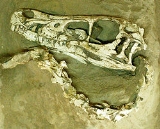
Velociraptor
Overview
Velociraptor is a genus
of dromaeosaurid
theropod
dinosaur
that existed approximately 75 to 71 million years ago during the later part of the Cretaceous
Period. Two species are currently recognized, although others have been assigned in the past. The type species
is V. mongoliensis; fossil
s of this species have been discovered in Mongolia
. A second species, V. osmolskae, was named in 2008 for skull material from Inner Mongolia
, China
.
Smaller than other dromaeosaurids like Deinonychus
and Achillobator
, Velociraptor nevertheless shared many of the same anatomical
features.
Genus
In biology, a genus is a low-level taxonomic rank used in the biological classification of living and fossil organisms, which is an example of definition by genus and differentia...
of dromaeosaurid
Dromaeosauridae
Dromaeosauridae is a family of bird-like theropod dinosaurs. They were small- to medium-sized feathered carnivores that flourished in the Cretaceous Period. The name Dromaeosauridae means 'running lizards', from Greek dromeus meaning 'runner' and sauros meaning 'lizard'...
theropod
Theropoda
Theropoda is both a suborder of bipedal saurischian dinosaurs, and a clade consisting of that suborder and its descendants . Dinosaurs belonging to the suborder theropoda were primarily carnivorous, although a number of theropod groups evolved herbivory, omnivory, and insectivory...
dinosaur
Dinosaur
Dinosaurs are a diverse group of animals of the clade and superorder Dinosauria. They were the dominant terrestrial vertebrates for over 160 million years, from the late Triassic period until the end of the Cretaceous , when the Cretaceous–Paleogene extinction event led to the extinction of...
that existed approximately 75 to 71 million years ago during the later part of the Cretaceous
Cretaceous
The Cretaceous , derived from the Latin "creta" , usually abbreviated K for its German translation Kreide , is a geologic period and system from circa to million years ago. In the geologic timescale, the Cretaceous follows the Jurassic period and is followed by the Paleogene period of the...
Period. Two species are currently recognized, although others have been assigned in the past. The type species
Type species
In biological nomenclature, a type species is both a concept and a practical system which is used in the classification and nomenclature of animals and plants. The value of a "type species" lies in the fact that it makes clear what is meant by a particular genus name. A type species is the species...
is V. mongoliensis; fossil
Fossil
Fossils are the preserved remains or traces of animals , plants, and other organisms from the remote past...
s of this species have been discovered in Mongolia
Mongolia
Mongolia is a landlocked country in East and Central Asia. It is bordered by Russia to the north and China to the south, east and west. Although Mongolia does not share a border with Kazakhstan, its western-most point is only from Kazakhstan's eastern tip. Ulan Bator, the capital and largest...
. A second species, V. osmolskae, was named in 2008 for skull material from Inner Mongolia
Inner Mongolia
Inner Mongolia is an autonomous region of the People's Republic of China, located in the northern region of the country. Inner Mongolia shares an international border with the countries of Mongolia and the Russian Federation...
, China
China
Chinese civilization may refer to:* China for more general discussion of the country.* Chinese culture* Greater China, the transnational community of ethnic Chinese.* History of China* Sinosphere, the area historically affected by Chinese culture...
.
Smaller than other dromaeosaurids like Deinonychus
Deinonychus
Deinonychus was a genus of carnivorous dromaeosaurid dinosaur. There is one described species, Deinonychus antirrhopus. This 3.4 meter long dinosaur lived during the early Cretaceous Period, about 115–108 million years ago . Fossils have been recovered from the U.S...
and Achillobator
Achillobator
Achillobator is a genus of dromaeosaurid theropod dinosaur from the late Cretaceous Period of what is now Mongolia, about 90 million years ago. It was probably an active bipedal predator, hunting with the large sickle-shaped claw on the second toe of each hind foot...
, Velociraptor nevertheless shared many of the same anatomical
Anatomy
Anatomy is a branch of biology and medicine that is the consideration of the structure of living things. It is a general term that includes human anatomy, animal anatomy , and plant anatomy...
features.

